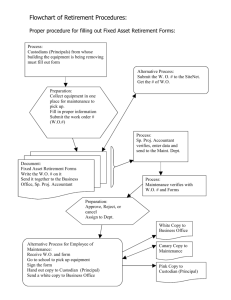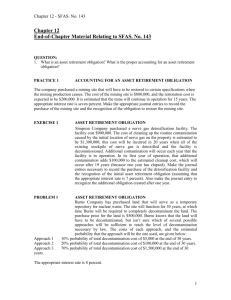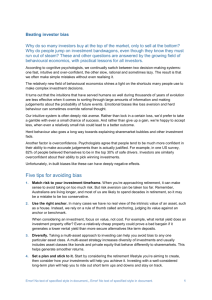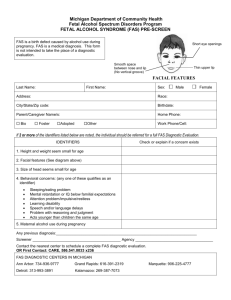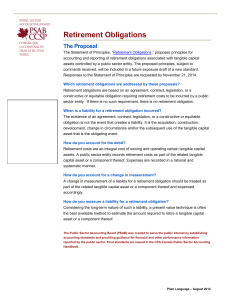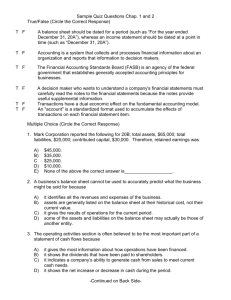Article (word document)
advertisement
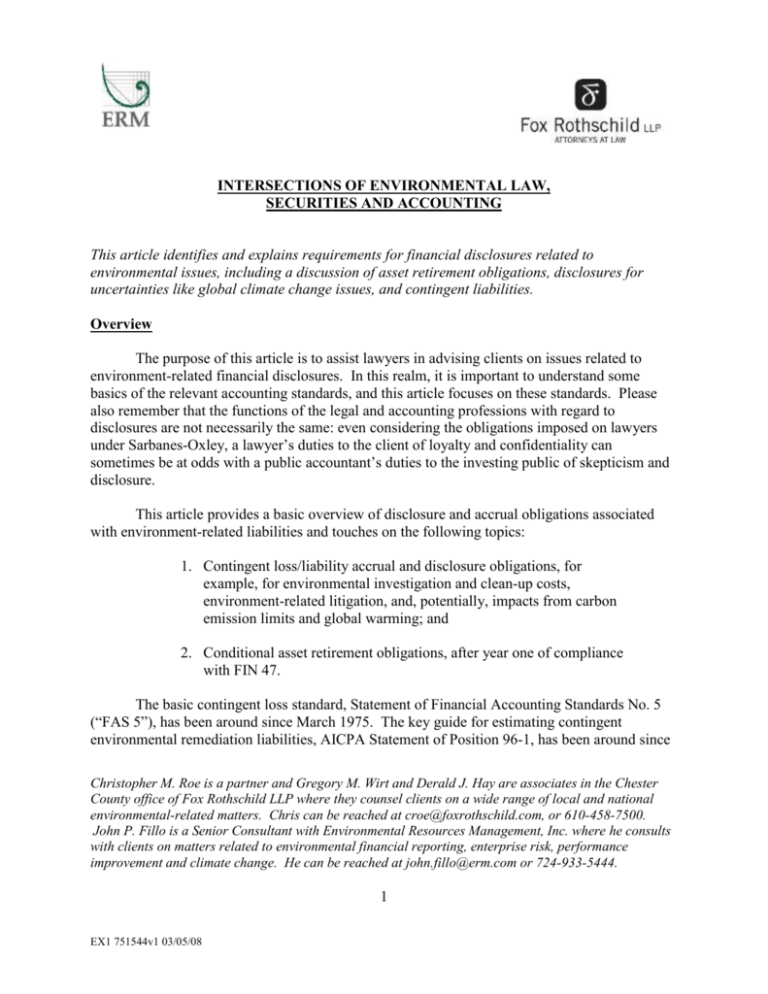
INTERSECTIONS OF ENVIRONMENTAL LAW, SECURITIES AND ACCOUNTING This article identifies and explains requirements for financial disclosures related to environmental issues, including a discussion of asset retirement obligations, disclosures for uncertainties like global climate change issues, and contingent liabilities. Overview The purpose of this article is to assist lawyers in advising clients on issues related to environment-related financial disclosures. In this realm, it is important to understand some basics of the relevant accounting standards, and this article focuses on these standards. Please also remember that the functions of the legal and accounting professions with regard to disclosures are not necessarily the same: even considering the obligations imposed on lawyers under Sarbanes-Oxley, a lawyer’s duties to the client of loyalty and confidentiality can sometimes be at odds with a public accountant’s duties to the investing public of skepticism and disclosure. This article provides a basic overview of disclosure and accrual obligations associated with environment-related liabilities and touches on the following topics: 1. Contingent loss/liability accrual and disclosure obligations, for example, for environmental investigation and clean-up costs, environment-related litigation, and, potentially, impacts from carbon emission limits and global warming; and 2. Conditional asset retirement obligations, after year one of compliance with FIN 47. The basic contingent loss standard, Statement of Financial Accounting Standards No. 5 (“FAS 5”), has been around since March 1975. The key guide for estimating contingent environmental remediation liabilities, AICPA Statement of Position 96-1, has been around since Christopher M. Roe is a partner and Gregory M. Wirt and Derald J. Hay are associates in the Chester County office of Fox Rothschild LLP where they counsel clients on a wide range of local and national environmental-related matters. Chris can be reached at croe@foxrothschild.com, or 610-458-7500. John P. Fillo is a Senior Consultant with Environmental Resources Management, Inc. where he consults with clients on matters related to environmental financial reporting, enterprise risk, performance improvement and climate change. He can be reached at john.fillo@erm.com or 724-933-5444. 1 EX1 751544v1 03/05/08 1996. In 2006, however, the Securities and Exchange Commission (“SEC”) brought and resolved a significant enforcement action against Ashland, Inc. and its environmental remediation manager regarding environmental remediation accruals and disclosures. The SEC also issued comment letters to other companies around environment-related reporting practices. The Ashland case highlights how even mature remediation responsibilities, in companies with sophisticated processes for generating estimates of contingent liabilities and setting reserves, can give rise to enforcement exposure related to persistent, long-term environmental accruals, especially given the heightened sensitivities generated by the Sarbanes-Oxley Act of 2002. The basic conditional asset retirement obligation standard, Statement of Financial Accounting Standards No. 143 (“FAS 143”), was issued in June 2001. The recent interpretative guidance, Financial Accounting Standards Board Interpretation No. 47 (“FIN 47”), was only intended to further illuminate existing concepts. In fact, significant, specific FIN 47 disclosures and notes to financial statements have been commonplace since the issuance of FIN 47 in 2005, including by some of the largest companies. Additionally, there have been recent developments that may affect the manner in which a company needs to address requirements associated with environmental exposures and liabilities that are briefly discussed, along with their potential implications. Sources of Authority By way of a broad overview, the Securities Act of 1933 and the Securities and Exchange Act of 1934, and the regulations promulgated thereunder, require that certain information be made available by persons selling securities and that the information be accurate. The SEC was established by the 1934 Act. The SEC was given broad authority over all aspects of the securities industry. In response to certain corporate scandals that revealed instances of insufficient auditor independence, a lack of adequate internal controls, and business leaders who claimed to not be aware of irregularities in their own organizations, the Sarbanes-Oxley Act of 2002 mandated a number of reforms to enhance corporate responsibility, enhance financial disclosures and combat corporate and accounting fraud, and created an oversight board to oversee the activities of the auditing profession. Sarbanes-Oxley also imposes certain objectives on lawyers who are deemed to be practicing before the Commission. The SEC requires publicly traded companies to prepare and file certain periodic reports, (such as 10-Q (quarterly), 10-K (annual) and 8-K (episodic)) and specifically requires that those financial statements comply with “generally accepted accounting principles” (“GAAP”). In fact, the rules state that statements filed with the Commission which are not prepared in accordance with GAAP “will be presumed to be misleading or inaccurate.” 17 CFR 210.4-01. This means that the standards developed by the Financial Accounting Standards Board (“FASB”), a private sector, independent body set up to establish standards of financial accounting and reporting, have become integrated into the SEC regulatory scheme. The SEC has 2 EX1 751544v1 03/05/08 deferred to and has officially recognized the standards developed by FASB as authoritative (Financial Reporting Release No. 1, Section 101 and reaffirmed in its April 2003 Policy Statement). Similarly, the American Institute of Certified Public Accountants (“AICPA”) has adopted FASB standards as authoritative for its members (Rule 203, Rules of Professional Conduct, as amended May 1973 and May 1979). In addition, Philadelphia’s own American Society of Testing and Materials (“ASTM”) has developed voluntary best-practices guidelines, including ASTM Standards E 2137-06 (“Standard Guide for Estimating Monetary Costs and Liabilities for Environmental Matters”), employing an expected value methodology for cost estimates; and E-2173-06 (“Standard Guide for Disclosures of Environmental Liabilities”), which calls for potential liabilities to be expressed in aggregate. 1 A petition was filed with the SEC several years ago seeking to have the SEC adopt these approaches as mandatory. Standard E 2137-06 states that it is not intended to supersede accounting and actuarial standards including those by the FASB and the SEC. Additionally, the standard does not address the establishment of reserves or disclosure requirements. A. Securities Regulations SEC regulations related to the disclosure of environmental liabilities include the following: Sec. 229.101(c)(xii) (Item 101), which requires a company to disclose material2 effects of compliance with environmental laws: Appropriate disclosure also shall be made as to the material effects that compliance with Federal, State and local provisions which have been enacted or adopted regulating the discharge of materials into the environment, or otherwise relating to the protection of the environment, may have upon the capital expenditures, earnings and competitive position of the registrant and its subsidiaries. The registrant shall disclose any material estimated capital expenditures for environmental control facilities for the remainder of its current fiscal year and its succeeding fiscal year and for such further periods as the registrant may deem materials. 17 CFR 229.101(c)(xii). Sec. 229.103 (Item 103) requires a brief description of any material pending legal proceedings, other than ordinary routine litigation incidental to the business, to which the registrant or any of its subsidiaries is a party or of which any of their property is the subject, which, and as to releases to the environment, provides: 1 Rulemaking petition submitted by the Rose Foundation for Communities and the Environmental (SEC File #4-463). 2 Whether a company is required to make a disclosure of environmental costs or loss contingencies under Item 101 or Item 303 is predicated on whether the costs or loss contingencies are considered “material.” Generally, an item is material if there is a substantial likelihood that its disclosure would be viewed by a “reasonable investor” as having significantly altered the “total mix” of information based on which he or she determines whether to invest. See TSC Industries Inc. v. Northway, Inc., 426 U.S. 438, 448 (1976). 3 EX1 751544v1 03/05/08 an administrative or judicial proceeding . . . arising under any Federal, State or local provisions that have been enacted or adopted regulating the discharge of materials into the environment or primary for the purpose of protecting the environment shall not be deemed ‘ordinary routine litigation incidental to the business’ and shall be described if: A. Such proceeding is material to the business or financial condition of the registrant; B. Such proceeding involves primarily a claim for damages, or involves potential monetary sanctions, capital expenditures, deferred charges or charges to income and the amount involved, exclusive of interest and costs, exceeds 10 percent of the current assets of the registrant and its subsidiaries on a consolidated basis; or C. A governmental authority is a party to such proceeding and such proceeding involves potential monetary sanctions, unless the registrant reasonably believes that such proceeding will result in no monetary sanctions, or in monetary sanctions, exclusive of interest and costs, of less than $100,000; provided, however, that such proceedings which are similar in nature may be grouped and described generically. 17 CFR 229.103 (Item 103). Sec. 229.303 (Item 303) which requires management's discussion and analysis (“MD&A”) of financial condition and results of operations. The instructions to Item 303 provide, in part: 1. The registrant's discussion and analysis shall be of the financial statements and of other statistical data that the registrant believes will enhance a reader's understanding of its financial condition, changes in financial condition and results of operations. 2. ….. 3. The discussion and analysis shall focus specifically on material events and uncertainties known to management that would cause reported financial information not to be necessarily indicative of future operating results or of future financial condition. This would include descriptions and amounts of (A) matters that would have an impact on future operations and have not had an impact in the past, and (B) matters that have had an impact on reported operations and are not expected to have an impact upon future operations. This MD&A requirement in Item 303 is the primary place where a growing number of investor groups and organizations and environmental activists (Ceres, the Rose Foundation, 4 EX1 751544v1 03/05/08 Interfaith Center on Corporate Responsibility and some of the largest public pension funds, among others), are pushing, including through proxy proposals and resolutions, for companies to provide information and to address the uncertainties “known to management” about potentially significant “impact on future operations.” These resolutions have addressed restrictions on carbon emissions, as well as the potential physical effects on assets and resources, related to global warming, as well as emissions reductions overall, and sustainable development reporting. These groups are also urging the SEC to require more specific information on greenhouse gas emissions and potential impacts of global warming. In part, these groups have relied on the Kyoto Protocol, which went into effect after being signed by Russia in 2005, and to which Canada, the European Union and other countries are signatories, as the basis for the contention that control of carbon emissions is a known trend that many public companies will at least need to contend with in Protocol countries. More fuel for this effort continues to occur. 1. States like New York, New Hampshire, Massachusetts (in part driven by the Regional Greenhouse Gas Initiative, of which Pennsylvania is an identified “observer”) and others have either proposed or implemented more stringent emissions control legislation, including for control of CO2 emissions, with some targeted to specific industry sectors (i.e., electric power generation). 2. In September 2006, California enacted AB 32, which requires the California Air Resources Board to develop regulations and market mechanisms designed to ultimately reduce California's greenhouse gas (GhG) emissions by 25 percent by 2020, including mandatory reporting rules by January 1, 2009 and a statewide GhG emission cap to begin in 2012 for significant sources, and to adopt regulations by January 1, 2011 to achieve the maximum technologically feasible and cost-effective reductions in GhGs. 3. In July 2007, New Jersey enacted A3331, the Global Warming Response Act, setting green house gas emission reduction goals for 2020 (i.e., equal to the 1990 level of statewide emissions) and 2050 (i.e., 80 percent reduction from 2006 statewide emissions), as well as the adoption of rules and regulations to establish a green house gas emission monitoring and reporting program no later January 1, 2009. 4. Activity on the federal landscape continues to increase with a stated Congressional goal to implement GhG legislation. As of mid-2007, the 110th Congress had seen over 70 bills, resolutions or amendments addressing climate change. The basic stated goals of investor and environmental groups include to require public companies to: assess greenhouse gas emissions in operations, products and supply chains; evaluate climate risk to assets and operations (through weather events, regulatory changes, energy cost, access to insurance, etc.); set credible emissions reduction targets and develop strategies to meet them based on energy efficiency, conservation and low-carbon technologies; and invest in renewable energy and development of low carbon, energy-efficient technologies. Based on shareholder resolutions slated for the 2008 proxy season, 33 of over 300 pending 5 EX1 751544v1 03/05/08 resolutions are related to climate change including climate change/green house gas reporting, energy efficiency/renewable energy, emissions reductions, political contributions, sustainable forestry, and financing for a broad spectrum of industries. Some public companies have responded, and others are likely to follow. For example, the United States Climate Action Partnership, a coalition of US-based and non-US-based companies and non-governmental organizations, is recommending prompt enactment of legislation in the United State to slow, stop and reverse green house gas emissions over the shortest period of time reasonably achievable. This coalition has grown from the original 13 members to 33 over the past year. 3 B. FASB Guidance Some of the accounting guidance essential to understand disclosure requirements related to environmental liabilities includes: FAS 5, Accounting for Contingencies, and documents that interpret its requirements, including: SOP 96-1, Environmental Remediation Liabilities; and FAS 143, Accounting for Asset Retirement Obligations, and documents that interpret its requirements, including: FIN 47, Accounting for Conditional Asset Retirement Obligations 1. FAS 5 - Accounting for Contingencies (Issued 3/75) FAS 5 establishes standards of financial accounting and reporting for loss contingencies. FAS 5 requires that an estimated loss from a loss contingency shall be accrued by a charge to income if both of the following conditions are met: a. Information available prior to issuance of the financial statements indicates that it is probable that an asset had been impaired or a liability had been incurred at the date of the financial statements. It is implicit in this condition that it must be probable that one or more future events will occur confirming the fact of the loss. b. The amount of loss can be reasonably estimated.4 FAS 5 defines the likelihood of a loss contingency as follows: Remote - - The chance of the future event or events occurring is slight. 3 The Proxy Resolutions Book, January 15, 2008, Interfaith Center on Corporate Responsibility FASB FIN 14, Reasonable estimation of the Amount of loss provides guidance where a range of loss can be reasonably estimated but no single amount within the range appears best. 4 6 EX1 751544v1 03/05/08 Reasonably possible - - The chance of the future event or events occurring is more than remote but less than likely. Probable - - The future event or events are likely to occur. 2. AICPA Statement of Position No. 96-1 (October 1996), Environmental Remediation Liabilities (“SOP 96-1”) SOP 96-1 provides guidance for the determination of when environmental remediation liabilities should be recognized in accordance with FAS 5. Under SOP 96-1, an accrual for environmental liabilities should include incremental direct costs of the remediation effort and costs of compensation and benefits for those employees who are expected to devote a significant amount of time directly to the remediation effort, to the extent of the time expected to be spent directly on the remediation effort. The measurement of the liability should include: 1. The entity’s allocable share of the liability for a specific site; and 2. The entity’s share of amounts related to the site that will not be paid by other potentially responsible parties or the government. Measurement of the liability is to be based on enacted laws and existing regulations and policies, and on the remediation technology that is expected to be approved to complete the remediation effort. Additionally, measurement of the liability should be based on the reporting entity’s estimates of what it will cost to perform all elements of the remediation effort when they are expected to be performed. The measurement may be discounted to reflect the time value of money if the aggregate amount of the liability or component of the liability and the amount and timing of cash payments for the liability or component are fixed or reliably determinable. SOP 96-1 also includes examples meant to provide guidance on the display of environmental remediation liabilities in financial statements and on disclosures about environmental-cost-related accounting principles, environmental remediation loss contingencies, and other loss contingency disclosure considerations. 3. FAS 143 and FIN 47 - - Conditional Asset Retirement Obligations In June 2001, FASB issued FAS 143, Statement of Financial Accounting Standards No. 143, Accounting for Asset Retirement Obligations, to establish more standardized methods of accounting in the present for the costs of legal obligations5 that need to be satisfied at the inevitable retirement of a tangible long-lived asset at the end of its useful life in the future. FAS 143 provides that an entity is required to recognize the fair value of a liability for an asset 5 For purposes of FAS 143, a legal obligation can result from (a) a government action, such as a law, statute, or ordinance, (b) an agreement between entities, such as a written or oral contract, or (c) a promise conveyed to a third party that imposes a reasonable expectation of performance upon the promisor under the doctrine of promissory estoppel. 7 EX1 751544v1 03/05/08 retirement obligation for long-lived tangible assets in the period in which the obligation is incurred if a reasonable estimate of fair value6 can be made. FAS 143, § 3. For an asset with an existing asset retirement obligation, the date the asset is acquired is considered the date on which the asset retirement obligation is incurred. FAS 143 is not, on its face, primarily aimed at or limited to environment-related asset retirement obligations, but it can address obligations predicated on environmental requirements. Examples of disclosures that have been made include disclosures related to reclamation and closure requirements for: 1. 2. 3. 4. 5. Ash landfills Ash ponds/surface impoundments Mine closure/reclamation and tailings ponds Above ground and underground storage tanks Nuclear power plant decommissioning In issuing FAS 143, FASB explained that an environmental remediation liability that results from the normal operation of a long-lived asset, and that is associated with the retirement of the asset, must be accounted for under FAS 143. On the other hand, an environmental remediation liability that results from other than normal operation of a long-lived asset likely falls under FAS 5 and SOP 96-1. This explanation, though, when applied, may seem like a significant over-simplification to an environmental lawyer trying to assist his or her client or the client’s accountant. For example, FASB’s explanation distinguishes between “a certain amount of spillage that may be inherent in the normal operations of a fuel storage facility” (and may trigger accounting under FAS 143) and compares that to a spill that occurs as a result of a “catastrophic accident” (potentially triggering treatment under FAS 5 and SOP 96-1). As environmental practitioners, we know that the bulk of environmental contamination at a fuel storage facility is not easily attributable to one or more catastrophic events. On the other hand, it also is not likely present due to “proper” operation of the assets, but to significant (perhaps unidentified) spill events and chronic leaks from tanks, lines, coupling devices and joints. FAS 143 also states that the fair value of the costs of required “intermediate capping activities” for a landfill (presumably not simply the application of daily cover) as well as the costs of required closure and post-closure care, should be accounted for under FAS 143. Similarly, groundwater contamination that may be caused by a breach in landfill containment would require consideration as an event not consistent with ‘normal’ operation of the landfill, and accounting for these additional costs as FAS 5 liabilities. In 2005, FASB issued an interpretation of FAS 143 that put a spot-light on potential environment-related asset retirement obligations, and in doing so has significantly impacted the earnings of companies across a broad range of industries. FASB’s interpretation, known as FIN 47 (FASB Interpretation No. 47, Accounting for Conditional Asset Retirement Obligations an interpretation of FASB Statement No. 143), points out that FAS 143 requires that an entity Under FAS 143, “fair value” means the amount at which a liability could be settled in a transaction between willing parties. FAS 143, § 7. 6 8 EX1 751544v1 03/05/08 recognize the fair value of a “conditional asset retirement obligation” before the event that either requires or waives performance of the obligation occurs. FAS 143, § A23. For the sake of FAS 143 and FIN 47, the term “conditional asset retirement obligation” means “a legal obligation to perform an asset retirement activity in which the timing and (or) method of settlement are conditional on a future event that may or may not be within the control of the entity.” FIN 47, § 3. An entity is therefore required to recognize the liability for the fair value of a conditional asset retirement obligation when the obligation is incurred (i.e., acquisition, construction, development, or normal operation of the asset) if the fair value of the obligation can be reasonably estimated. The examples provided in FIN 47 are all related to requirements of environmental law. Once again, these examples may raise as many questions in the mind of an environmental practitioner as they answer. Each example is discussed below. Example 1. A telecommunications company utilizes chemically treated utility poles in its operations. The entity periodically replaces the poles for operational reasons. Legislation exists in the state in which the company operates that would require special disposal procedures for the treated wooden poles. Even though the timing of the asset retirement activity is conditional on the removal and disposal of the poles, and the poles may be disposed of, reused or sold by the telecommunications company, FIN 47 requires that the utility state, at the date of the purchase of the poles, an estimated fair value of the liability for the required disposal procedures using an expected present value technique. FIN 47, §§ A2 – A5. In other words, should the state’s solid or hazardous waste management laws and/or regulations impose legal requirements for the poles when disposed at the end of their useful life, the company must recognize the fair value of the cost of complying with those requirements in its current accounting. Example 2. An entity utilizes kiln bricks in its operations. The bricks have been purchased by the entity, but not used in any operations. The bricks will become contaminated with hazardous materials when the kiln is operated, and state law requires disposal of the contaminated bricks at a hazardous waste site upon removal. According to FIN 47, once the bricks are placed in service, the entity has the ability to estimate the range of potential settlement dates, the method of settlement, and the probabilities associated with potential settlement dates based on its past operations of the kiln and the replacement of bricks. The fair value of the asset retirement obligation for the bricks should be recognized once the kilns have been placed in service and the bricks contaminated. The fair value of the disposal procedures can be estimated using an expected present value technique. FIN 47, §§ A6- A8. Presumably, of course, once the bricks are contaminated to any degree they will be required by environmental law to be specially handled at some level, for example, they will fall outside Pennsylvania’s Disposal of Fill Policy. The “hazardous waste” treatment in this example, therefore, is likely unnecessary to the FIN 47 obligation, though it will be very relevant to estimating the fair value of the end of life obligation. 9 EX1 751544v1 03/05/08 Example 3. An entity acquires a factory containing asbestos. Following the acquisition, regulations are enacted requiring special handling and disposal of the asbestos if the factory undergoes major renovations or is demolished. The entity could potentially retire the facility by demolishing, selling or abandoning it. The entity does not expect to undertake a renovation of the facility that would require removal and disposal of the asbestos. While the timing of the retirement of the facility is conditional on the date of major renovations or demolition of the facility, the regulations impose an obligation on the entity to dispose of the asbestos in a special manner. The entity is required to recognize the fair value of the retirement obligation when the regulations are enacted if it can reasonably estimate the fair value of the liability. If the entity believes the range of settlement dates is unknown or cannot be estimated, the entity must disclose a description of the obligation, the fact that a liability has not been recognized because the fair value cannot be estimated and the reasons why fair value cannot be reasonably estimated. FIN 47, §§ A9 – A10. Example 4. Similar to Example 3, an entity acquires a factory containing asbestos. Regulations are in place that require special handling and disposal of the asbestos if the factory undergoes major renovations or is demolished. At the time of acquisition, the entity believes the obligation has an indeterminate settlement date, an active market does not exist to transfer the obligation, and sufficient information is not available to apply a present value technique. Ten years after the acquisition the entity obtains additional information based on changes in demand for the products manufactured at the facility. At that time, the entity is able to estimate the range of potential settlement dates, the potential methods of settlement, and the probabilities associated with the potential settlement dates and methods of settlement. The entity would be required to recognize the asset retirement obligation for the asbestos ten years after the acquisition of the facility, because sufficient information exists at that time to estimate the fair value of the obligation. Similar to Example 3 above, the entity is not required to recognize the asset retirement obligation at the time the facility is acquired if the entity determines it does not have sufficient information. The lack of sufficient information to estimate the fair value of the obligation does not relieve the entity of its burden to disclose the obligation however. At the time of the acquisition, the entity would be required to disclose a description of the obligation, the fact that a liability has not been recognized because its fair value cannot be estimated, and the reasons why the fair value cannot be estimated. FIN 47, §§ A11-A13. For an environmental practitioner, these examples suggest some disconnect between accounting theory and the reality of the information that is kept and reasonably available to businesses with significant assets. Many, if not most, long-lived assets (assets with a useful life of 10 years or more) used in business and industry require some special handling under local ordinance or state or federal solid or hazardous waste laws, when they are disposed of at the end of their useful lives, often simply because they are wastes that result from commercial or industrial activities. Similarly, many assets, or parts thereof, contain hazardous substances or become contaminated through use with, for example, inks, oils, or metal dusts. Characterization of these assets for disposal purposes likely will not have occurred until there is a need to dispose of them. Similarly, while there are companies that have conducted or leveraged prior surveys as one basis to estimate asbestos abatement obligations, many companies have not conducted surveys of each of their facilities and have chosen for worker health and safety and NESHAP compliance purposes to treat all suspect materials as asbestos-containing until disturbed for 10 EX1 751544v1 03/05/08 renovation or demolition. Under FIN 47 these companies may have to choose between potentially overstating asset retirement obligations by assuming all suspect material will require handling under the asbestos NESHAP upon retirement, or undertaking asbestos surveys on a portion of or all of their assets – surveys that have not been necessary for compliance with environmental law. There is a long list of items that may warrant consideration under FIN 47 because of the potential existence of legal requirements triggered at retirement. Some examples of items that may at least warrant assessment for FIN 47 applicability are as follows: 1. Lead-based paint 2. PCB-containing electrical equipment 3. Mercury-containing control equipment 4. Spent catalyst / sorbents 5. Stored process residues 6. Pipeline residuals 7. Electronic equipment 8. SF6 Equipment 9. Nuclear sources 10. HVAC / duct cleanout (Pharmaceutical Good Management Practice) 11. Lease obligations 12. Franchise / Right of Way assets 13. Universal waste 14. HCFC refrigerants 15. Product inventory 16. Used tires While this list is by no means comprehensive, it is just as important for companies to understand and document the underlying basis for such disclosures or, alternatively, the basis upon which a company has determined that a FIN 47 disclosure is not required or not material. As suggested above, application of FIN 47 to contaminated sites (including Brownfields) can be complex, due to a multitude of factors: 1. 2. 3. 4. 5. 6. 7. What are the applicable legal requirements? What constitutes ‘normal’ operation? Physical asset retirement Lease obligations Promissory estoppel Hazardous materials management Environmental remediation requirements Liabilities associated with existing contaminated and/or Brownfield sites may already have been addressed under companies’ FAS 5 liability disclosures. Companies responsible for such sites, or considering acquisition of them, should consider that there may be associated asset retirement obligations and FAS 5 liabilities that need to be quantified, recorded and disclosed. 11 EX1 751544v1 03/05/08 A survey of disclosures following the adoption of FIN 47 illustrates the obligations to which FIN 47 may apply, as well. For example, companies have provided disclosures regarding asbestos abatement, PCB removal, removal/disposal of oil and gas offshore platforms and pipelines, fuel storage tanks, removal of hazardous materials from facilities, and restoration of real estate pursuant to lease agreements. The initial impact of FIN 47 occurred in 2006 as companies were required to account for the prior purchases of assets that carry future environmental liabilities. It is likely however, that significant questions will continue to arise as the respective disclosures are compared and analyzed: 1. The rationale for accruing conditional asset retirement obligations or revising accruals must be reviewed periodically to accurately reflect material interim changes in the financial statements. Changes in the business such as acquisitions, divestitures, plant retrofits and closings, etc. can affect the existence and magnitude of these accruals. 2. There may be an evolving distinction between liabilities accrued as asset retirement obligations or conditional asset retirement obligations; or contingent liabilities in consideration of environmental conditions generated as a result of ‘normal operations’. 3. FIN 47 prompted some companies to reassess their prior work on FAS 143. In so doing, companies needed to calibrate the accuracy of underlying assumptions and how changes in these assumptions may affect the associated accounting. While the veracity of these assumptions was further confirmed in many cases, there were instances where asset-specific assumptions were not entirely appropriate and required correction in later financial statements. 4. Review the sufficiency of existing Sarbanes-Oxley controls for FAS 143 should have been part of application of FIN 47. New or updated controls may have been required to address the broader applicability of FIN 47. 5. SEC has been reviewing companies’ disclosures and has been issuing inquiries as an integral component of comment letters. The outcome from these inquiries is yet to be determined. 12 EX1 751544v1 03/05/08
